#woodland stonecrop
Text


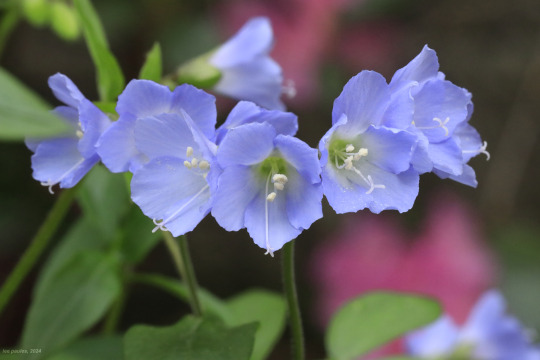









Update on the native wildflower shade garden . . .
Since my last post about the sharp-lobed hepatica several weeks ago, the wildflowers in the shade garden have made a significant push. All of the live plants I put in the ground last fall have made it through the winter, and many of the seeds I planted have germinated and sprouted. Quick survey:
Top: the spreading Jacob's ladder (Polemonium reptans) is mounding beautifully and positively dripping with violet-blue, bell-shaped flowers. The plant lures many pollinators, including bees, flies, butterflies, moths, and beetles. And that foliage is so lush and green . . .
Next one: woodland stonecrop (Sedum ternatum) has established itself in the nooks and crannies of one of my rock features and is getting ready to bloom.
Next two: although the sharp-lobed hepatica (Hepatica acutiloba) has nearly finished blooming, the real joy starts for me when the leathery, thrice-lobed leaves with their often deeply-variegated patterns begin to unfold. This is flat-out one of the most unique and gorgeous wildflowers of North America.
Next one: creeping woodland phlox (Phlox stolonifera) makes for an enchanting ground cover and will spread quite rapidly in the right conditions. I have strong feelings for all the native phlox species, but this one has stolen my heart. It's native to a narrow strip of the Appalachian Mountains from Georgia to Pennsylvania. In the spring around here, it absolutely lights up streambanks with its dainty pink to rose-colored flowers.
Next one: dwarf-crested iris (Iris cristata) is another lovely groundcover but beware - it spreads like wildfire. The lavender and yellow to orange-crested flowers are a treasure to behold from late April to early May. And its arrow-like foliage provides much-needed contrast in the garden.
Next: among the seeds I planted, the yellow pimpernel (Taenidia integerrima) is making the strongest push. The plant produces yellow-flowered umbels similar to golden Alexanders and is a high-value nectar source for many pollinators. It's also the host plant for the black swallowtail and Ozark swallowtail butterflies.
Next two: anyone who visits this Tumblr regularly needs no introduction to heartleaf foamflower (Tiarella cordifolia), my unofficial poster child for Appalachian spring. I simply would not have a native wildflower garden without it. One of my foamflowers is a hybrid (sugar and spice) cultivated for its deeply dissected leaves and intense variegation.
Last (but not least): my eastern red columbine (Aquilegia canadensis) pretty much takes cares of itself - it's one of the best starter wildflowers for beginner gardeners, hardy and undemanding. But man, does it produce loads of beautiful red and yellow, bell-shaped flowers.
#appalachia#west virginia#vandalia#flora#spring#native wildflowers#shade garden#native wildflower garden#spreading jacob's ladder#woodland stonecrop#sharp-lobed hepatica#creeping woodland phlox#dwarf-crested iris#yellow pimpernel#heartleaf foamflower#eastern red columbine
41 notes
·
View notes
Text
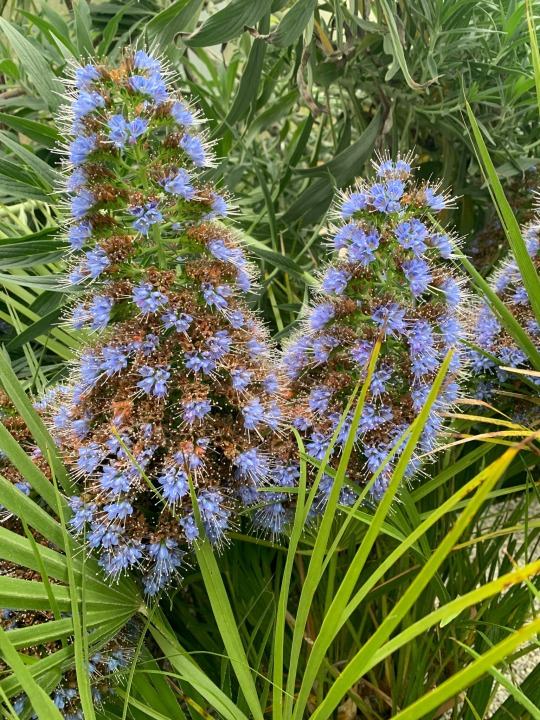





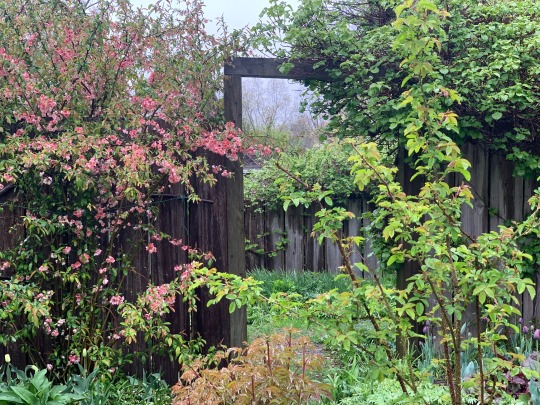


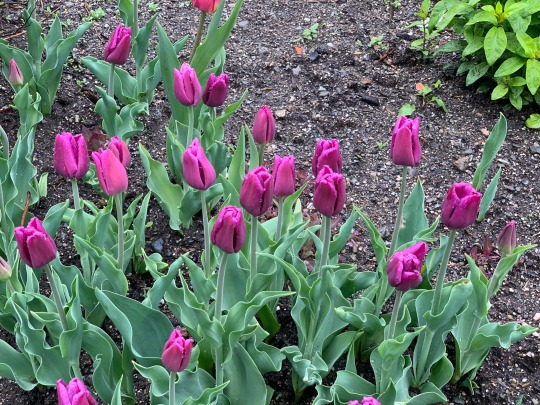
Spring at Stonecrop Gardens.
#stonecrop#garden#flowers#gardening#gardens#photography#woodland#newyork#cold spring#garrison#flower bulbs#tulips
42 notes
·
View notes
Text
So uh. About 12 years ago I thought it'd be fun to do Sherlock Holmes set in the Redwall universe. I wrote a bit for it, then lost interest and moved on to other things.
Well, between my Redwall reread and the Letters from Watson substack, I've recently found myself with renewed interest in both Redwall and Holmes stories, so I decided to dust off the ol' Redwall AU. I reread what I had, found it almost entirely unusable, and completely reworked it. And now I have a humble little introduction here!
Don't know if I'll continue this, but I've had a LOT of fun ideas over the last week, so we'll see!
*****
Extract from the personal journal of Lancejack Johnswort Swifteye, formerly of the Fur and Foot Fighters Border Patrol—
The first day of spring has come and gone. The days grow warmer and longer as we leave winter further behind—the Winter of the Sweeping Mists, by Abbey reckoning. By my own reckoning it was the Winter of Abject Misery.
For six seasons I have marched with the Fur and Foot Fighters Border Patrol, that intrepid unit that keeps watch on the region where Mossflower meets the sand dunes by the Western Sea. Most of my comrades were Salamandastron hares, but with the border patrol’s proximity to the forest, they had plenty of use for squirrels like myself. Like many of my kind I am sharp of eye and handy with a bow, and between my childhood of helping in the Abbey Infirmary and my later training under Lieutenant Lagsworth, I had the skills to make myself useful as a healer as well.
It all came to an abrupt and inglorious end last winter, when a Galloper from the Long Patrol came to us warning of a corsair ship that had made landfall not far from our position. Word reached us too late that the ship was in fact a full fleet, and in the resulting battle I found myself cut off from the rest of the patrol during our retreat. I went down with several wounds, not the least of which was a bolt from a searat’s crossbow in my leg, and I would have been killed if Corporal Pennyroyal hadn’t dragged me to safety.
The patrol suffered heavier losses than it should have, with its principal healer gravely wounded. Penny tells me it was touch and go for a while, before reinforcements from Salamandastron arrived, led by Colonel Kordyne himself. In the end I survived, albeit severely weakened and with a newly-acquired limp, my military career indefinitely on hold if not outright over.
Once I was well enough to travel, I was swiftly sent on my way to Redwall by shrew logboat, and had scarcely passed a week in the willing paws of the abbeydwellers when I was struck down with a ferocious fever. The days and weeks that followed were miserable, full of aches and chills and horrendous dreams—and precious little company, as I was kept away from other creatures so as not to spread my illness to the rest of the abbey.
To add insult to injury, I missed the Nameday celebrations entirely, and by the time I had regained enough of an appetite to enjoy the taste of food, every crumb of that glorious feast had been eaten or sent out to the denizens of the surrounding woodlands in need of extra food after the winter.
It is strange to find myself walking Redwall’s venerable halls once more. I was quite young when I left, creeping out in the cover of night so as not to alert the elders to my departure. Back then I dreamed of returning in glorious triumph, and here I am now, scrawny and scarred and hobbling about with a cane on days when my leg gives me trouble. I keep busy how I can, usually helping Brother Stonecrop in the Infirmary, but more often than not I find myself passing days in a fog. I miss my comrades, the smell of the wind off the distant sea, the feeling of good bark beneath my claws. Embarrassment about my situation has made me a recluse. Stonecrop and I were friends as Dibbuns, and he is still good company, but in spite of his best efforts, in spite of the many good creatures who make their home in Redwall, I cannot recall ever feeling so terribly lonely.
****
The sound of pawsteps on the stone floor reached John’s ears. Briefly he considered snuffing out the candle and waiting silently for whoever it was to leave, but the thought felt unbearably childish. With a sigh, he set down his quill and blew gently on the still-wet ink.
“So that’s where you’ve been hiding.” Brother Stonecrop poked his head around the cask. “By the fur, how can you stand being down here so long on the cold stone?”
“It’s quiet,” John replied. “And before you ask, my leg feels fine. How’d you find me?”
“You certainly didn’t make it easy.” The stout mouse eased between the barrels and sat down with him, fidgeting until he’d smoothed out his habit. “I checked the infirmary and the top of the belltower first, and then I remembered Pinn saying she’d seen you creeping down here the other day.”
“I really thought I’d given her the slip,” John muttered, before a cloth-wrapped bundle was thrust into his inkstained paws. “Stonecrop, what—”
“You missed lunch again,” Stonecrop informed him. “I managed to rescue some cheese and nutbread and a scone before the young ones scoffed the lot. There’s a beaker of dandelion cordial as well. Get your jaws around that, see if it puts you in a better mood.”
“My mood is perfectly fine,” John protested. As if on cue, his traitorous stomach growled.
“Says the daft beast as he broods in the dark, scribbling out his thoughts by candlelight.”
“Alright, alright.” John bit into the scone and almost groaned. “Hell’s teeth, that’s good. How is it still warm?”
“Alright, so I didn’t actually snatch it from the jaws of a ravenous mousebabe,” Stonecrop admitted. “I stopped by the kitchens for a fresh one. I thought if you were making yourself this hard to find, it was a scone-straight-from-the-ovens sort of day.”
In spite of himself, John couldn’t help but smile. “Thanks, Stonecrop.”
Stonecrop clapped him on the back. “Think nothing of it, old Swifteye. Somebeast has to make sure you don’t waste away to nothing.”
“I’m nowhere near old.”
“Is that a fact? I could hardly tell, when you’ve got a face on you like a decrepit frog more often than not.” Stonecrop’s tone, light as it was, betrayed his worry. “You know it wouldn’t hurt to attend a meal every now and then. It’d be good for you to have some company once in a while.”
“I know, I know, it just…” John sipped from the beaker to buy himself time to think. “It gets a bit loud, especially with how voices echo in this place. And the last time I was somewhere loud, it wasn’t one of my good days.”
Stonecrop frowned. “I would think Dibbuns shrieking at dinnertime was a far cry from a battlefield.”
“You would think.”
“Well…” John could almost hear Stonecrop’s thoughts whirring as he hunted for a solution. “Would it help to get out of the abbey for a bit? You’ve hardly left since you got here—obviously you couldn’t with the fever, but you’re hale and healthy now, besides the leg. A bit of fresh air never harmed anybeast. Matter of fact, I’ve been doing some spring cleaning in the infirmary, and some of my herb stores need to be restocked.”
“It… would be nice to walk among proper trees again,” John admitted. “Though with my luck, I’d go out for a leisurely stroll and run straight into a robber gang.”
“Good thing you’re in an abbey full to the brim with willing, helpful beasts,” Stonecrop pointed out. “Why don’t I send you and somebeast else out on a little herb-gathering mission for me?”
“I’m not some restless young one you need to keep busy,” John told him, finishing up the last of the cheese.
“No, you’re a restless fully grown squirrel who needs to keep busy before he crawls out of his own fur,” Stonecrop said dryly.
“Yes, yes, you’re right.” John sighed. “You’re right. I’ve just been… I don’t know how to explain it.”
“Lonely?”
“I don’t know if it’s that,” John flicked away the last few crumbs of nutbread. “But it feels the same whether I’m hiding down here or standing in the middle of a crowded Cavern Hole, so I may as well feel it without forcing my awful moods on somebeast else.”
Stonecrop placed a paw on his shoulder. “That’s no good and you know it, John. Starving the body won’t cure it of sickness, and starving the spirit won’t cure it of sadness, either.”
“I’m not sad, I’m just… I’m not exactly what anybeast would consider good company.”
Stonecrop took long enough to reply for John to finish the rest of his meal. When he glanced over again, he found the mouse looking at him thoughtfully.
“What?”
“It’s funny, I was just thinking… you’re not the first creature to say that to me in the last few days,” Stonecrop said, stroking his whiskers.
“So there’s another unsociable hermit in the abbey? I’m shocked we haven’t run into each other in the same hidden-away nook.”
“You’d be surprised,” Stonecrop chuckled. “But no, he’s been away from the abbey for most of the winter and just returned this past week. Bit of an odd one, but clever as anything. Knows the woods like the back of his paw, too. It was actually him I asked first about herbs, and he was all for helping until somebeast else came along with a more interesting problem for him to solve.”
“Not very courteous of him.”
“Oh, that’s just how he is,” Stonecrop said with a shrug. “But either way my stores need replenishing, and I’ve been busy with cleaning and early springtime sniffles. Would you be willing to lend me a paw?”
John sighed, trying not to smile and failing. “Well, when you put it like that, I’d be a real puddenhead to say no, wouldn’t I?”
“That’s the spirit!” Stonecrop heaved himself to his footpaws before reaching down to pull John up alongside him. “Come along then, let’s get you back out into the sunlight. Meet me in the infirmary and we can go over the list—I’ll go let Hemlock know I won’t be needing him after all.”
“Actually…” For a moment, John teetered on the edge of indecision, before he steeled himself and swallowed his ever-present doubts. “I think I’ll come along with you. You’ve got me curious about this Hemlock fellow.”
Stonecrop’s eyebrows shot up. “Oh? Well this is a pleasant surprise.”
“I rarely hear a cross word from you about anybeast,” John pointed out. “So if he’s odd enough for even you to remark upon it…”
“Well, don’t say I didn’t warn you,” Stonecrop chuckled, a bit nervously. “Just try to keep an open mind.”
Curiosity piqued, John followed him out of the cellar, through the Great Hall and out onto the abbey lawns. From the looks of it, most creatures had taken advantage of the warming weather to have lunch outside. The food was cleared away, but rumpled blankets still lay strewn across the grass, and sticky-pawed Dibbuns dashed about playing while their elders cleared away dishes and napkins.
The gatehouse door stood ajar when they reached it, and Stonecrop knocked twice before pushing it fully open and stepping inside. “Are you in there, Hemlock?”
There was no reply, but the sound of pages turning told them that somebeast was inside, at least. The gatehouse was a cluttered mess, and the sounds of life came from somewhere behind the stacks of old tomes and loose parchment that covered the desk.
Before Stonecrop could call out again, the unseen creature gave a great “Ha!” before slamming a book shut and nearly knocking the chair over in a mad scurry for the door.
Behind Stonecrop, John froze, and his mouth dropped open.
There was a ferret in the gatehouse—better fed and groomed than others of his kind that John had encountered, but a ferret nonetheless. From head to toe his brown fur was so dark it was nearly black, with flashes of white over his muzzle and ears, and a thin layer of dust over all.
“Solved it!” he crowed triumphantly, waving a slip of parchment. “Terribly sorry for the wait, Stonecrop, Myrtus presented me with a puzzle the other day and it couldn’t wait.”
“Sounds like it was a real poser,” Stonecrop said.
“A decent diversion. How close is it to noon?”
“About two hours past,” Stonecrop replied.
The ferret beamed. “Excellent timing! This is the best part—come, this way, you’ll both enjoy this.”
Without waiting for a reply, the ferret seized them both by their sleeves and pulled them out of the gatehouse, then released them and took off for the orchards at a quick lope.
John was left staring after him, mouth still hanging open. Wordlessly he turned to Stonecrop.
“I did say he was odd and to keep an open mind,” Stonecrop sighed. “We’d better see what he’s found.”
They caught up to the ferret at the wall nearest the orchard, walking quickly along its length and tapping each sandstone block as he went. “Well, what is it, Hemlock?” Stonecrop asked.
“Twelve, thirteen—hush, I’m counting—fourteen, fifteen…” The ferret carried on until he reached the middle of the wall, then turned his back was to it and began counting his steps. Before long they were within the shade of the orchard, and the ferret had halted at a damson tree and was squinting at something on the ground. With a noise of sudden understanding he darted along its shadow until he reached its end, counted several more steps, and stopped at an apple tree.
“Here it is!” The ferret inspected the tree trunk, then stared up into its branches, before turning and locking eyes with John. “The smallest favor, if you don’t mind—could you climb up there and see if you can find this?” He passed the slip of parchment to John. Scribbled on it was the symbol of a flower with star-shaped leaves.
Luckily today was a good day, and his leg didn’t pain him beyond a bit of stiffness. With one last baffled look at Stonecrop, John scaled the tree with ease. This early in spring, the boughs were mostly bare of leaves, and it took him several minutes to find the symbol. It wasn’t carved into the tree itself, but engraved on a small bronze disk embedded in one of the branches.
“Found it!” he called down.
“Which side of the tree?” the ferret asked.
“South!”
“Thank you!”
John climbed down to find the ferret down on all fours at the roots on the south side, digging furiously into the soil with both paws.
“Would you like me to find Foremole?” Stonecrop asked.
“No, I’ve got it!”
Soil flew into a growing pile behind him; the ferret dug with single-minded determination until his head was fully out of sight. Minutes passed before John heard a thud and curse, and the ferret’s dirt-covered face poked back into view.
“It’ll just be a moment more, I’ve just hit it,” he said, before diving back down with renewed energy.
“Just hit what?” John mouthed to Stonecrop, who shrugged helplessly at him and crouched down for a better look.
Eventually the ferret rose again with a grunt of effort, and lifted out an old, dirt-caked chest secured with a rusted lock. The ferret dove down again, produced a sizable rock from the hole he’d just dug, and smashed it off. Then he lifted the lid, peered inside, and gave a bark of triumphant laughter.
“Well?” Stonecrop spoke up. “Don’t keep us in suspense, what have you found?”
“No gold or jewels, if that’s what you’re wondering,” the ferret replied. “These are the journals of Brother Mallowgreen, during the reign of Abbot Kastel. There’s a bit of a gap in the abbey’s history during that time, thanks to the abbot’s rather unfortunate penchant for destroying records he didn’t like. Luckily, the Infirmary keeper at the time had the presence of mind to hide his own scribblings, and was kind enough to leave behind a few riddles leading to their location.” He lifted himself out of the hole and dusted off his paws, gray eyes alight with satisfaction. “And I do love a good riddle.”
“And you took all of two and a half days to solve it,” Stonecrop remarked.
“As I said, a decent diversion.” The ferret’s eyes settled on John again. “Hello.”
“Ah, right—Hemlock, this is John Swifteye, an old friend of mine. John, this is Hemlock, who I told you about.”
“Pleasure.” Hemlock’s pawshake was firm but not so tight as to be painful. “I didn’t know Stonecrop’s friendships extended as far as the Fur and Foot Fighters of the western dunes.”
“I, er, haven’t been back here in some time,” John stammered out, caught off guard.
“Do your herbs still need restocking, by the way?” Hemlock asked Stonecrop. “I know it’s been a few days.”
“You know, I was just coming to let you know that I’d found somebeast else for the task,” Stonecrop replied. “But it looks like you’re free again.”
“It might be a two-beast job, given the state of your stores when I last saw them,” Hemlock pointed out, with a glance at John. “I wouldn’t mind the extra paws, especially if it means having an archer along. Never mind being out of practice—any ne’er do wells we find in the woods today will most likely flee at a warning shot.”
“Um,” said John.
“If you’re not averse to my company, of course,” Hemlock added with a smile.
“I—not at all,” John answered without thinking. “If you don’t mind slowing up for a squirrel with a limp.”
“Well then.” Hemlock scooped up the chest and tucked it under one arm. “I’ll go run this little find up to the attic, and then I’ve got to nip down to the kitchens for something. See you at the east wallgate, Swifteye.” With that, he was gone.
John waited until Hemlock was well out of earshot before jabbing his paw into Stonecrop’s ribs. “Out with it, Stonecrop, how many others have you gossiped to about me?”
“I didn’t!” Stonecrop was grinning. “On my honor, I never breathed a word about you, to him or anybeast else. I told you he’s clever.”
“What have I gotten myself into?” John asked.
Stonecrop slung a friendly paw around his shoulders and began leading him back to the abbey building. “Only one way to find out.”
They had only just reached the lawn when, behind them, the deep voice of Brother Bramlen the gardener rang out from beneath the trees.
“WHO IN THE NAME O’ SPIKES HAS BEEN DIGGIN’ UP ME TREES?” the hedgehog bellowed. “HEMLOCK!”
Squirrel and mouse beat a hasty retreat, laughing like misbehaving young ones.
****
True to his word, Hemlock was waiting by the east wallgate when John made his way down. The ferret was cloaked warmly for the lingering winter’s chill, and carried an empty basket with one paw and, oddly enough, what seemed to be a fully-packed haversack on his shoulders. John had a basket of his own, and had armed himself with bow, quiver, and a stout walking stick.
“Planning on spending the night, are you?” John asked, glancing at the pack.
“No,” Hemlock replied, and unbolted the gate. “After you.”
The sun was out, with more blue in the sky than gray. In spite of the warmth of sunlight, the air was still cold, even more so without the high abbey walls to block the wind. John’s injured leg gave a twinge, forcing him to lean on the stick a little more heavily than he would have liked.
Hemlock had taken the lead without a word, which was fair enough. Before he’d come limping to the abbey under the guidance of the Guosim, John hadn’t been this deep into Mossflower Wood since his nighttime escape as a wayward young one. Besides, if he wasn’t focused on pathfinding, it gave him a chance to size up his strange companion.
It wasn’t unheard of for vermin to live their lives in peace and quiet contentment. John had known of a few to the west—a weasel couple that farmed and fished in the woods, a solitary old rat that lived out in the dunes—and the patrol kept an eye out but otherwise left them alone. But that didn’t change the fact that, by and large, the vast majority that John had encountered had been… well. Roving bandits, robber gangs. Corsair fleets.
John glanced back at the sandstone wall looming over the tree tops, then again at Hemlock. Redwall’s charter had something or other about extending paws in peace and friendship, but that didn’t change the long history of vermin hordes showing up to try and conquer the place.
“Rest assured, that is not my intention,” Hemlock said dryly.
Startled, John nearly tripped. “I beg your pardon?”
“I was only a little older than a kit when I first came to Redwall,” Hemlock went on, picking his way carefully through a tangle of roots. “Rather a long time for a plot to simmer, wouldn’t you agree?”
John slowed, leaning heavily on his stick as he followed. “I didn’t—how did you—?”
“Your stare has been burning holes in the back of my head since we left,” Hemlock replied. At least he didn’t sound particularly offended. “And just now you looked back at the abbey as if to make sure it was still there, then very pointedly looked at all the spots on my person that might conceal weapons. It wasn’t difficult to follow your train of thought.”
“...Oh.” Sheepishly, John lapsed into silence.
Eventually Hemlock led the way to a patch of vervain, and John descended upon it. The plants were strong and healthy in spite of the recent winter, and before long the bottom of his basket was lined with it.
“I found feverfew not far from here, last time I passed through,” Hemlock spoke up suddenly. “Hopefully it’ll still be there—not much snow, this past winter, so it won’t have frozen.”
John pulled himself back up on his stick. His leg was beginning to ache, just slightly, but he could still walk a bit more. “Lead on.”
They found it near a massive fallen beech log, growing green and full out of the loam, though it was still too early in the season for flowers. Still, Stonecrop could do a lot with stems and leaves alone. When John was finished harvesting them, he found Hemlock sitting on the log waiting for him.
“Might as well sit for a bit,” the ferret said. “Rest that leg.”
“Oh. Er, thank you.” John leaned his stick against the log and climbed up to sit—not beside him, but near enough.
Truthfully, he was grateful. He hadn’t had much in the way of exercise recently, between injuries, fever, and moping. He could feel himself getting winded and tired more quickly than he ever had before. A long walk through the woods without rest was likely to make his leg worse.
Hemlock must have known. He certainly wasn’t resting for his own benefit.
“Can I ask you something?” John asked eventually.
“You may.”
“Stonecrop said he didn’t tell you about me,” said John. “Did somebeast else tell you who I was, or…?”
Hemlock’s gray eyes flitted up and down, taking in the whole of him again. “I hadn’t heard of you before Stonecrop introduced us.”
“Then how did you know I’m—I was one of the Fur and Foot Fighters?”
“Oh, a number of things,” Hemlock replied. “I looked at you and thought, here is a creature who carries himself like a trained soldier, with his best seasons before him but covered in scars old and new, with a freshly maimed leg and a recent bout of illness, in the middle of a vast forest that hasn’t seen much trouble from hordes and bandits in quite some time. The military bearing suggests the Long Patrol, but it’s extremely rare to see anybeast but a hare among them. And if you were in the Long Patrol, you would’ve rested from your hardships in Salamandastron. Then I remembered hearing of the recent visit from the Guosim, and that answered that. You came from the border between forest and sand, and your comrades saw fit to put you on a boat for home rather than send you on a long march over the dunes.” He paused. “The archery was easy enough—calluses on your paws and a thin patch on your inner arm where the bowstring wears at your fur when you fire.”
John gaped at him.
“It sounds complicated when I lay it all out, but it’s really not,” Hemlock finished. “Two and two make four.”
“And you know Redwall is ‘home’ for me because…?”
“The accent, obviously.”
“Obviously.” He hadn’t even known he had an accent.
“How’s the leg?” Hemlock asked.
John tested it, then carefully slid down to the ground. The ache was nearly gone. “Better, thank you.”
“Let’s be off, then. The infirmary’s stores don’t have a single stem of marigold left.”
Before they left, Hemlock shrugged the haversack from his shoulders and set it on the log. John watched him curiously as he wedged it in the fork of the roots so that it wouldn’t slide off.
“What are you doing?”
“Paying for services rendered,” Hemlock replied, leaving the pack where it sat. “Let’s be off.”
The ferret offered no further explanation. Something told John it would be useless to press.
****
“So what do you think of him?” Stonecrop asked later that evening, as they reorganized the herb stores.
“You were right,” John replied. “He’s an odd one and no mistake. Monstrously clever, though.”
“Oh, that he is.”
“He left a full haversack out in the woods,” John added, glancing at his friend. “Any idea what that’s about?”
“Ah, that.” Stonecrop grinned. “Don’t worry about that. You’ll find out soon enough.”
109 notes
·
View notes
Text
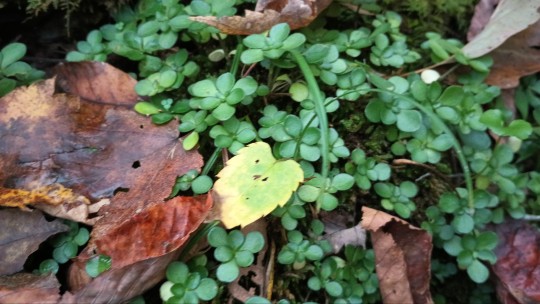
Woodland Stonecrop
Found and photographed: on an appalachian mountain biking trail in West Virginia
A pretty snack in your backyard? Low maintenance and beautiful, this succulent is the full package.
See more photos, and learn about Woodland Stonecrops below the cut!


You can eat it, use it on injuries, and it's local!
Named Stonecrop because of its ability to thrive atop boulders. This resilient plant survives in low sunlight and shallow soil by using its succulent leaves to retain water for long periods of time.
This could make a great low maintenance addition to your garden! It even flowers white April-May.
Medicinally, it can be used like aloe, leaves broken open and spread the gel inside on warts, insect bites, or burns to help soothe pain. It has even been said to have a cooling effect.
Cooking! This is my first edible plant, I hope you're excited to learn!
All parts of the Stonecrop plants are edibles from flowers to roots.
The leaves have been said to be edible raw, like in a salad, or you could cook them as pot herbs.
The roots of Stonecrop plants have been said to have a peppery, bitter taste, a good addition to spice up a dish! The roots are best harvested before the plant flowers, as the texture after flowering is unpleasant.
Edibility: Edible! All parts
Rarity: Common
Genus: Sedum
Regions: Eastern North America, from Arkansas to the East Coast.
Please do your own research, I am an enthusiast not a scientist. I'm here to share and have fun.
All photos taken by me: Toast Loafley/Juno S.
#nature#nature photography#succulents#medicinal plants#plants#plantblr#gardening#foraging#plant identification#ToastLoafley
13 notes
·
View notes
Text
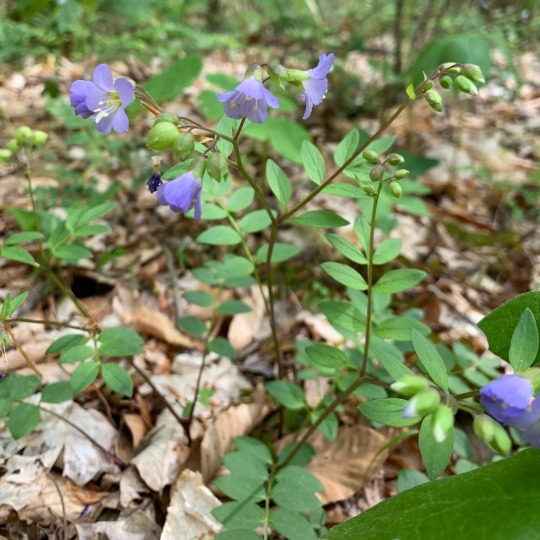
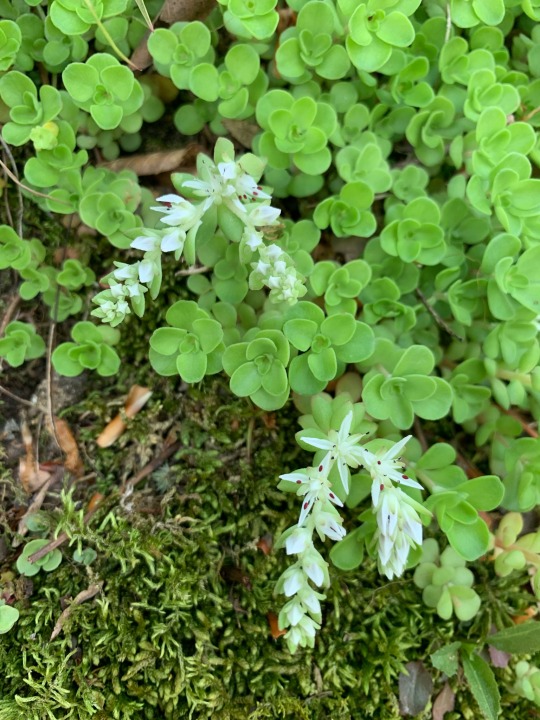
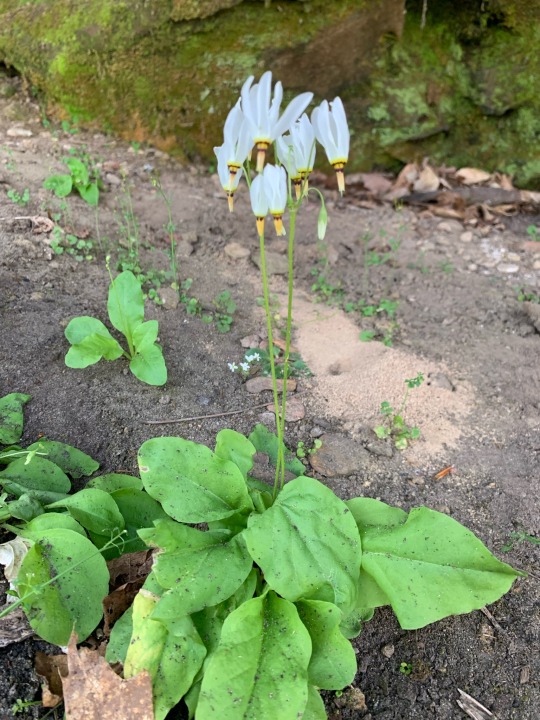

Polemonium reptans (jacob’s ladder) / Sedum ternatum (woodland stonecrop) / Primula frenchii (french’s shooting star) Conopholis americana (american cancer-root)
#flower#nature#wildflowers#naturecore#dirtcore#botany#native flowers#native plants#parasitic plants#forestcore
14 notes
·
View notes
Photo








Little outing today to Garden in the Woods. Lots of pretty flowers. (And turtles and frogs that did not photograph well.)
1. Forget-me-nots
2. Mountain laurel
3. a dragonfly
4. Bluets
5. Woodland stonecrop
6. Rhododendron
(the one that always startles me realizing that it’s both a native plant and that’s what its wild form looks like)
7. Moss with dramatic shadows
8. Ladybugs
25 notes
·
View notes
Note
I really love your nature headcanons! could we get some headcanons about the region of Dor Cuarthol?
Flora, fauna, geography and environment of Arda Masterlist
thank you! I love writing and researching for my nature headcanon posts!
Environment and Ecology of Dor-Cúrathol Headcanons
Let me know if you want a full flora and fauna post and as always please feel free to ask more!
Dor-Cúrathol (Sindarin: Land of Bow and Helm) was an area of Southwest Beleriand extending from the area Southwest of the River Teglin towards the Talath Dirnen with the House of Ransom on Amon Rûdh around the center and acting as a base of operations.
It existed for nearly a year until word reached Morgoth that the man calling himself the black sword was likely none other than the now grown son of his prisoner, Húrin Thalion. Mîm, the dwarf who’s home was used by Túrin and his outlaws betrayed the location of Túrin leading to the slaughter of his group
Dor Cúrathol was mainly open plains and fields with clusters of woodland near the river Teglin and the border to Brethil Forest. The forested areas are mostly deciduous with some coniferous trees especially closer to the river.
The climate was likely temperate with cold winters with significant snowfall. Wind speeds are likely relatively low except over parts of the Talath Dirnen. Rain showers are common through the mid spring to summer and then again for a short period in late autumn.
Silver birch, common beach and oak and hazel grow in the forested areas. Pines are rare but occur on some of the hills.
The grassy plains of Talath Dirnen were largely made up of a few species from the families cleistogenes and poa or needle and meadow grasses (I actually do have a flora and fauna post for that I want to rework). A variety of species in the Asteraceae or daisy family including sweet yarrow, mayweed, lavender cotton and more.
We are also given a few canonical species namely
-Rowan trees, also called mountain ashes. Ecologically important in that their fruits feed a huge variety of animals including red foxes, spotted nutcracker birds, song thrushes, dormice, redwings, roe deer and other cloven hooved creatures, and more.
-Silver Birch trees which incidentally occur in the same plant communities as rowan. Others in this plant community are common aspen, goat willow and red elderberry
-A species of gorse called aeglos or snow thorn (likely a white colored version of common gorse)
Roots likely from yam or similar
Seregon was a flower created by Tolkien noted for its blood red flowers. It was in the stonecrop or sedum family and others in the family also grew upon and around the hilltop possibly including goldmoss stonecrop, white stonecrop and tasteless stonecrop
Thorn trees
This one is difficult as the family collectively known as thorn trees would come from a different climate than the others described. Although with some shifting of species to others in their genus or family I could absolutely work with the Vachellia family to create a Talath Dirnen and Dor-Cúrathol inspired by South America or North Africa so let’s file that for later if there’s interest
Other possibilities include common hawthorn or common holly
Like many rivers in Beleriand, hemlock grows by the banks of the Teglin, potentially confused with wild carrot and Queen Anne’s Lace (nimfirgoloth in Sindarin or white autumn cluster-flowers, I made this name myself)
As always feel free to ask more!
12 notes
·
View notes
Text

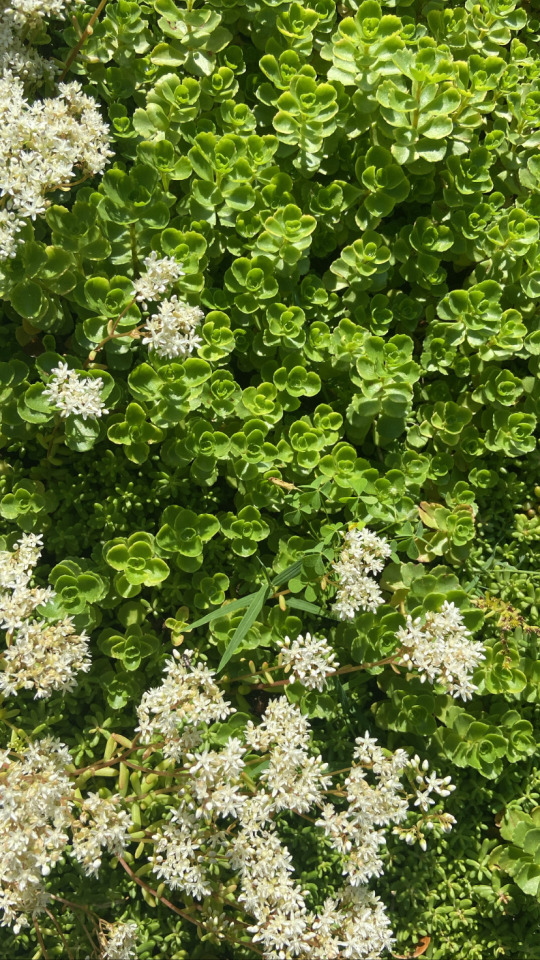
Thank you, @aspirebelieverecover, for encouraging me to post these photos from our garden.
Sedum Ternatum, Woodland Stonecrop: https://worldofsucculents.com/sedum-ternatum-woodland-stonecrop/
#personal#photography#warmcore#witchblr#humblr#cottage witch#cottagecore#cottageblr#country#garden#succulent#plant#plants#aesthetic#artist#warm and cozy#gardening#witchcore
0 notes
Text
Species observed 5/7/2023
Virginia spiderwort
Woodland stonecrop
One-flowered cancer-root
Wood nettle
American bladdernut
Jacob’s ladder
Hedge bedstraw
Deertongue
Cut-leaves toothwort
Sassafras
May apple
Bloodroot
Canadian wild ginger
Smooth Solomon’s seal
Solomon’s plume
Jack in the pulpit
Wild geranium
Drummond’s wood sorrel
0 notes
Text
April 29: Actual Spring
I keep forgetting to post! The first big accomplishment we've made is getting the crepe myrtle stump out. The quince went in, and it's showing some stress - probably the drastic temperature differences, but I gave it some extra fertilizer. We put in a new baptisia (pink lemonade), and the standard one from last year is coming in next to it.

All my plant shipments have come in, so I'm mostly just waiting for seedlings I started indoors to grow bigger before they go in the ground.


We got tons of rain yesterday, so some things are looking a bit soggy. A lot of what's in the native bed is violet, but I'm just letting it happen as natural ground cover. Better that than the creeping charlie covering most of the yard.
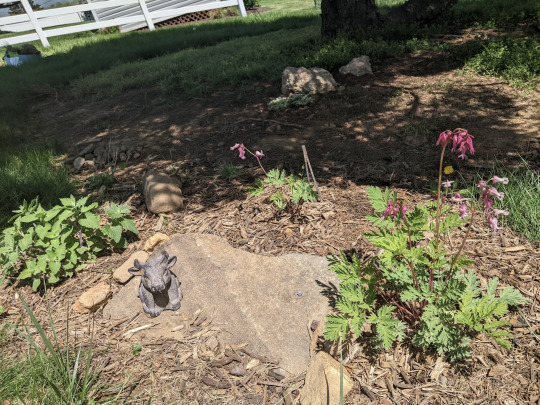
My bleeding hearts and catnip in the area around Cinders' grave came up with no issue, and I'm filling the back in with foamflower and woodland stonecrop. Katie's been hard at work at the edge of the yard, where she put in two blueberries and several hazelnuts - the former definitely being the needier plant as far as growing conditions go.




A few more new blooms!
0 notes
Text
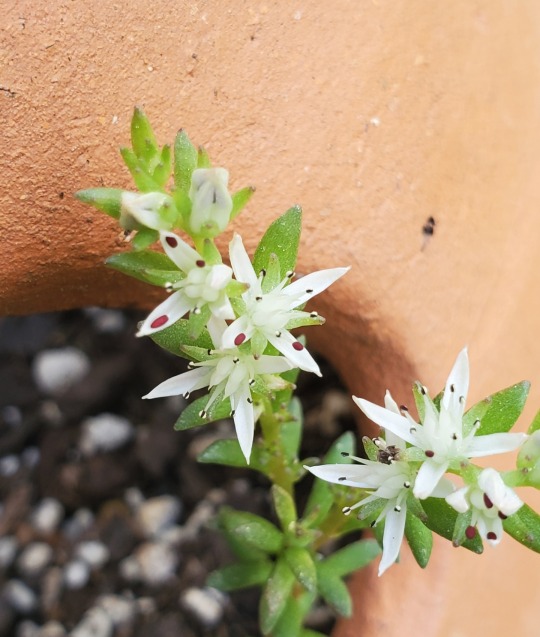
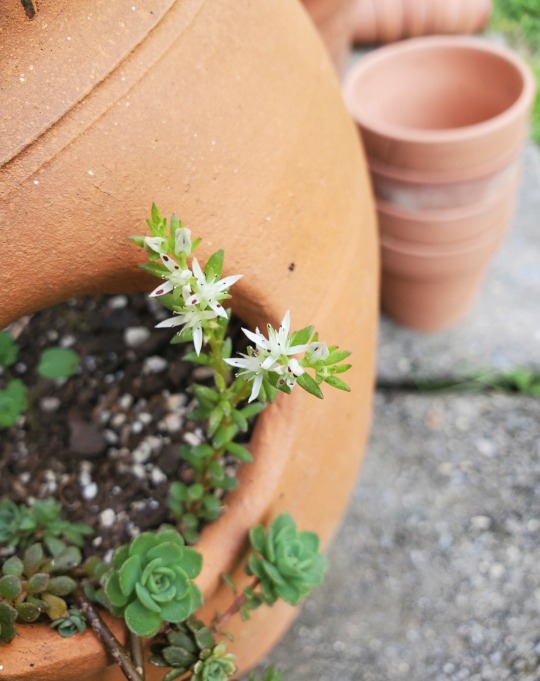
4/7/20
My friend brought this back from the Appalachian mountains for me as one tiny plant. He calls them hen-and-chicks.
1 note
·
View note
Text

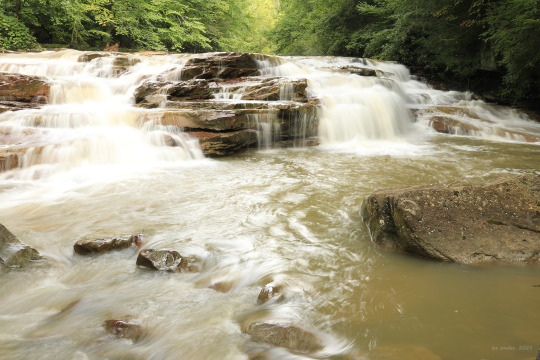


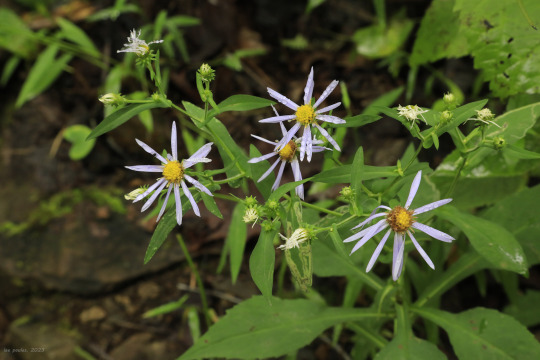
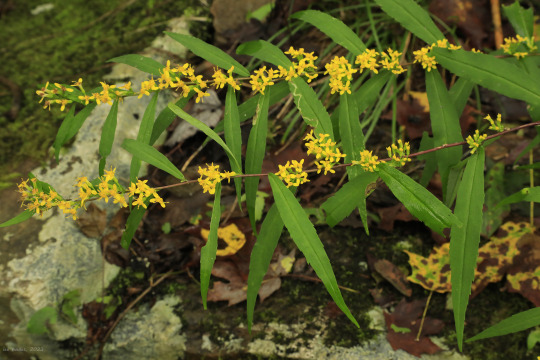
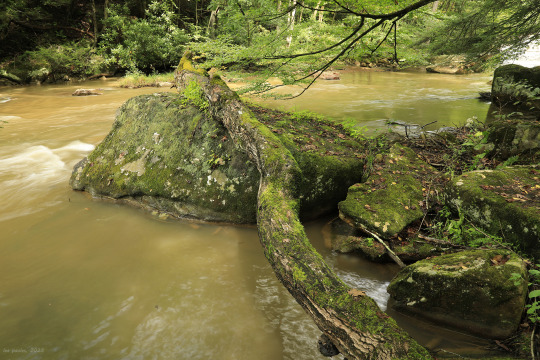
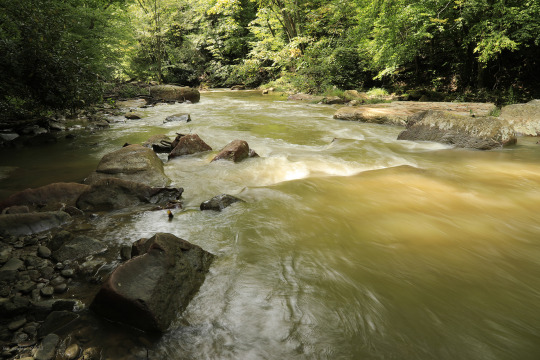
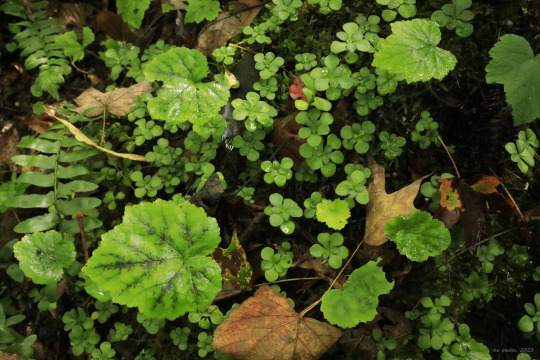

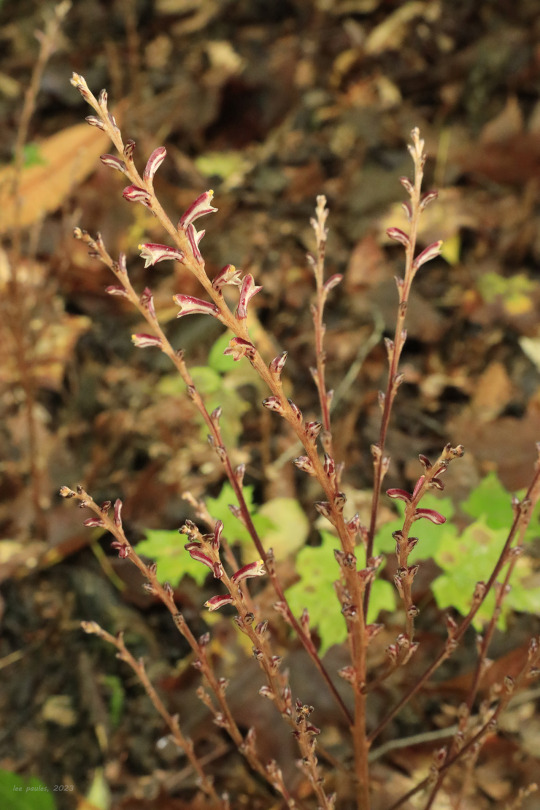
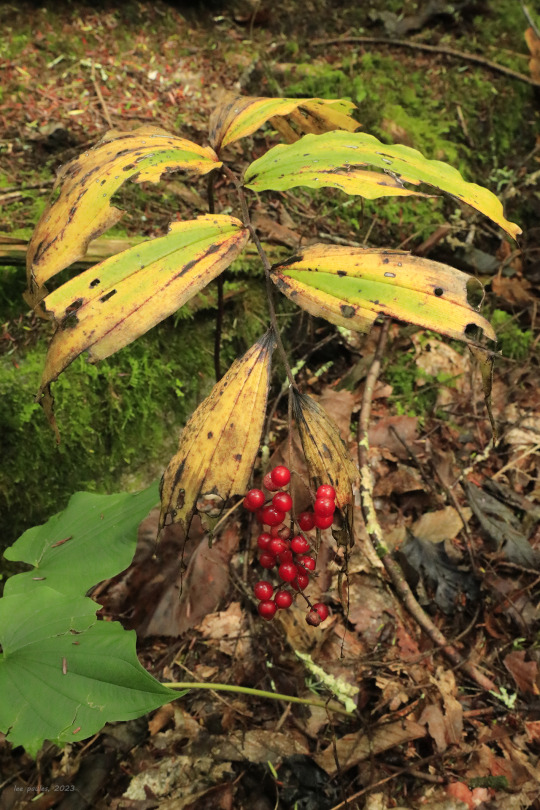
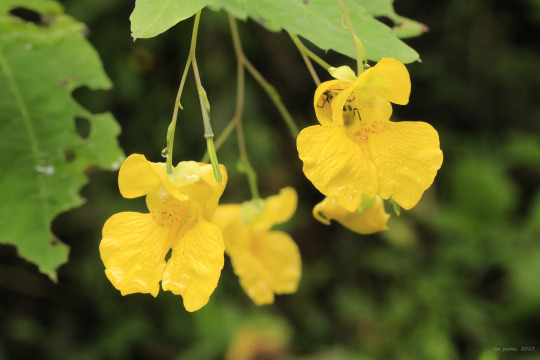
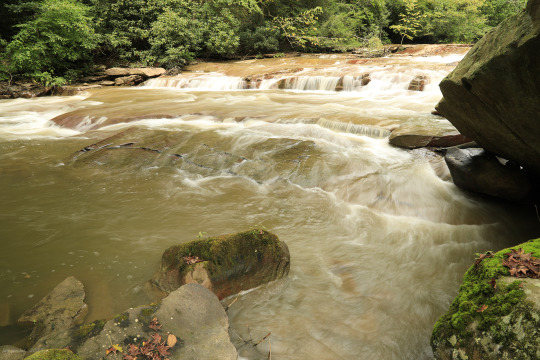

Despite its undignified name, Muddy Creek is a lovely mountain stream that normally runs fast and clear on its steep descent to Cheat River. But after a week of heavy rain in NC-WV, the stream looked a bit murky yesterday. Not even the sediment washing away from the mountains dims its beauty in my eyes. And the enchanting, moss-encrusted forest along its bank holds its own late summer treasures.
From top: great blue lobelia (Lobelia siphilitica), which pairs beautifully with cardinal flower to provide late summer color in a native wildflower garden; white wood aster (Eurybia divaricata), which is the most common of the shade-loving white asters in this area; crooked-stemmed aster (Symphyotrichum prenanthoides), also known as zigzag aster, whose clasping, spatula-shaped leaves distinguish it from big-leaf aster, another woods-loving aster with lavender flowers; blue-stemmed goldenrod (Solidago caesia), whose spreading, yellow-flowered stems provide stunning late-season color in a native wildflower garden; an intensely-green collage of moss, woodland stonecrop (Sedum ternatum), Christmas fern (Polystichum acrostichoides) and heartleaf foamflower (Tiarella cordifolia), which I am trying hard to reproduce in my own native wildflower shade garden; the shaggy-maned stem of Coker's Amanita (Amanita cokeri), one of the most impressive mushrooms of Appalachia's summer forests; beech-drops (Epifagus virginiana), a parasitic plant that grows and subsists on beach tree roots; the bright red berries of false Solomon's seal (Maianthemum racemosum); yellow jewelweed (Impatiens pallida), whose explosive seed pods give the plant its other common name, pale touch-me-not; and narrow-leaved tick-trefoil (Desmodium paniculatum), also known as panicled tick-trefoil, a late summer pea whose sticky seed pods commonly hitch rides on shoes and boots.
#appalachia#vandalia#west virginia#wildflowers#flora#summer#muddy creek#cheat river#preston county#fungi#coker's amanita#great blue lobelia#white wood aster#crooked-stemmed aster#zigzag aster#blue stemmed goldenrod#woodland stonecrop#christmas fern#heartleaf foamflower#beech-drops#beech drops#false solomon's seal#solomon's plume#yellow jewelweed#pale touch-me-not#narrow-leaved tick-trefoil#panicled tick-trefoil#falls#rapids#mountain stream
103 notes
·
View notes
Text
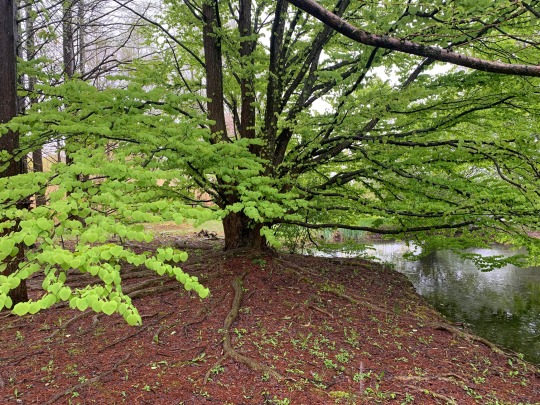


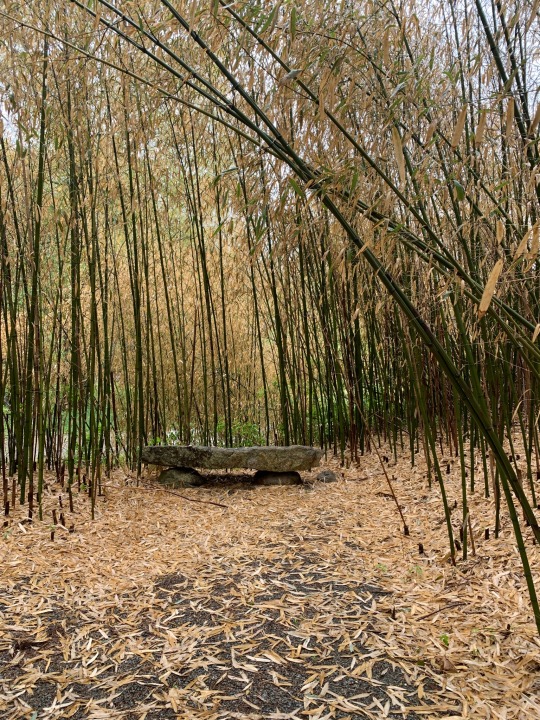



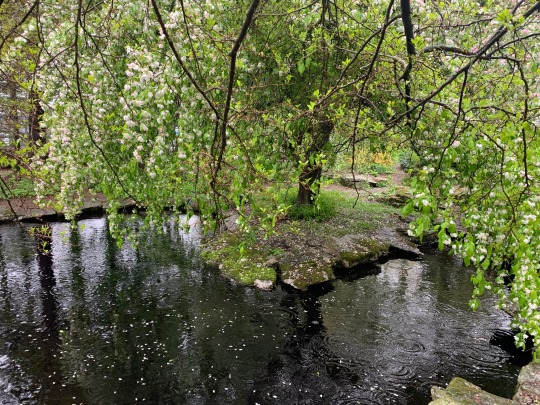


It was wonderful to stroll in the rain through this magical garden. Each season is stunning in Stonecrop. Members also gain access to their rare perennial and alpine seed banks.
#stonecrop#cold spring#rainyweather#new york#flowers#photography#woodland#woods#spring#nature#original photographers#flower#alpine#red wood#dawn redwood#rain rambles#rain
33 notes
·
View notes
Photo

88 notes
·
View notes
Text
this morning i woke up at sunrise and offered clovers and incense to the two maples my partner and i tapped for sap. two deer followed me to the second tree and peered at me from a few meters away. i’m constantly mentally berating myself for bringing gifts to the woods - i tell myself they’re only symbolic, that a tree has no use for incense and flowers, like the streambank has no use for the cut stonecrop i brought to it. and yet these visits where i bring gifts are marked by unique happenings that i don’t encounter the hundred other times i set foot in the woods. maybe it’s superstitious of me. maybe i don’t care. maybe worrying about whether it’s coincidence or not distracts me from simply experiencing the sweet joy these moments have to offer. i would rather carry a thousand offerings to the woods with gratitude in my heart than come empty-handed and steeled by intellect
#part of this too is my fear as an ecologist of negatively impacting the ecosystem#but i’m typically mindful of what i take and what i give#the input of organic matter in exchange for simpler sugar#trading stonecrop for the tree bark i’ve harvested#and i always tie honeysuckle by the roots around fallen trees#i want to do right by the woodland that sustains me
2 notes
·
View notes
Text

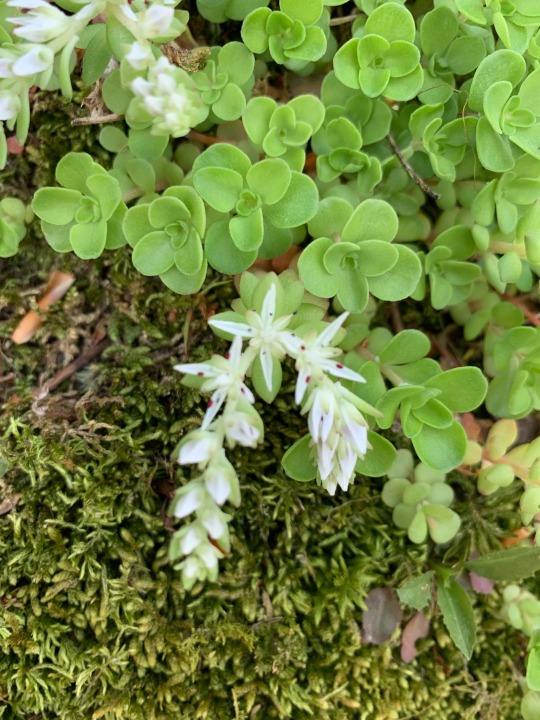
Sedum ternatum (woodland stonecrop)
7 notes
·
View notes